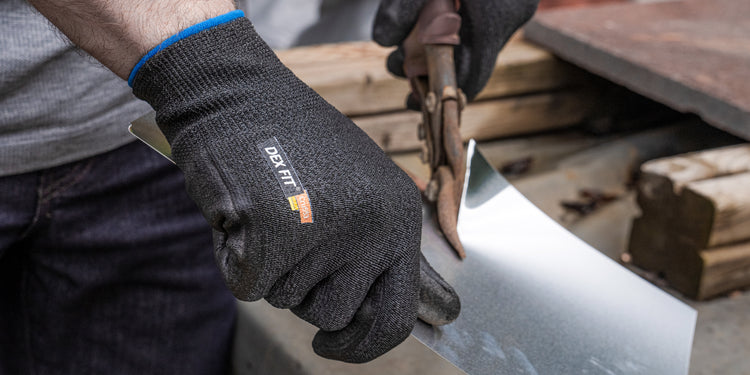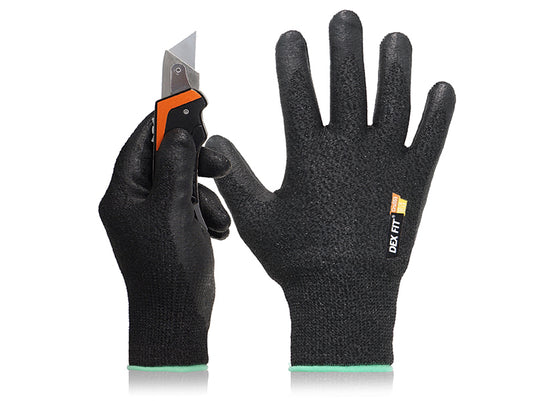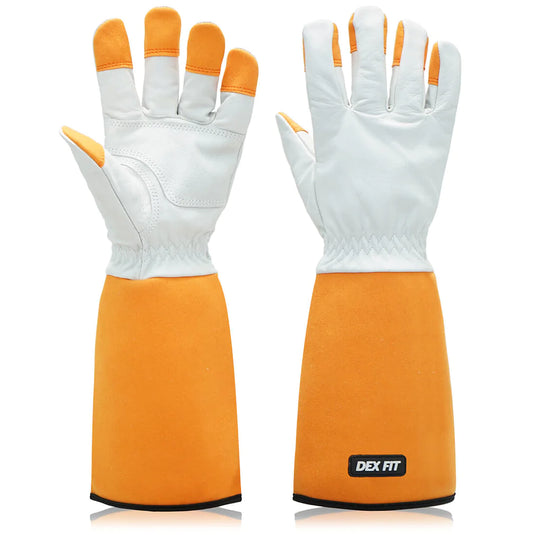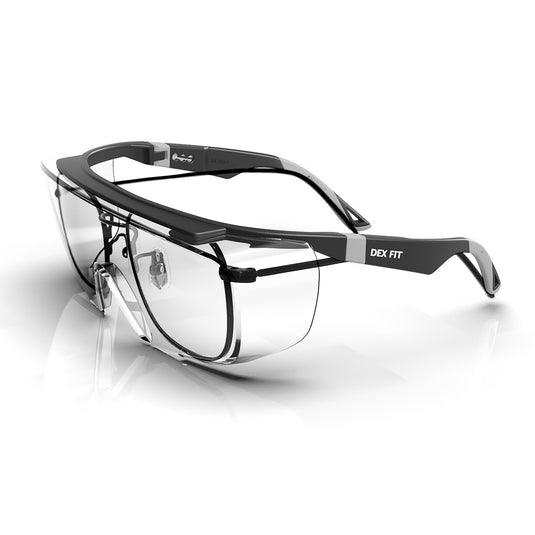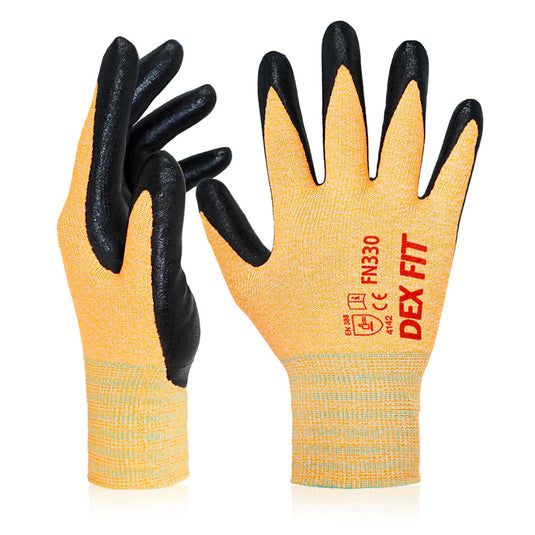Cut Resistant Gloves are the best protection option against cut hazards. These gloves are usually categorized into levels depending on their cut ratings; the higher the level, the greater the protection. A high cut-resistant rating means a greater weight was needed to cut through the glove’s fabric during testing.
To millions of workers in the automotive, glass, sheet metal, and construction industries, our hands are especially a vital part of productivity.
Our hands have 29 bones along with major nerves, arteries, veins, tendons, ligaments, cartilages, skin, and fingernails. They serve critical functions, but most workers tend to take hand injuries too lightly. This resulted in hand injuries ranking 2nd in the list of most frequent injuries on worksites. For non-surgical treatments, it costs an average of $6,000 USD in the United States to treat hand injuries.
Even a few stitches can add up wiping out part of your savings if you are ill-prepared. Not only are there potential financial repercussions, hand injuries can also cause huge disruptions at work. If we can prevent hand injuries, we will be able to prevent inconveniences such as financial loss and time as well.
The common types of workplace hand injuries are:
- Skin Irritation
- Burns
- Sprains & Strains
- Fractures
- Abrasion and lacerations
- Stabs
Wearing a pair of gloves is enough to prevent these injuries from happening while working. Now, we’ll explain the different cut-resistant levels there are and what kind of gloves are the best fit for you.
Depending on the type of work you do, there are different levels of cut-resistance that a glove possesses. When it comes to cut resistance levels, there are two classification systems that you have to know, the American National Standards Institute (ANSI) and the European Commission’s EN 388 system. First, let’s take a look at the levels from ANSI in order to know what is suitable for your work environment.
Check out the ANSI levels below:
A1 (200–499 grams) – Nuisance Cuts: This level covers general material handling as well as small parts assembly tasks. It provides the most amount of dexterity but can only be used for light cut hazards.
A2 (500–999 grams) – Low Cut Hazards: Most common in construction and package handling jobs. An A2 level glove can only help with low-cut hazards like pulp and paper jobs.
A3 (1000–1499 grams) – Light/Moderate Cut Hazards: Expect more reasonable protection with this level especially when dealing with sharp edges and accidental contact with sharp objects during raw material handling and general manufacturing.
A4 (1500–2199 grams) – Moderate Cut Hazards: For those who are regularly handling knives this level might be good for you. Most commonly used in food preparations or processing, HVAC, and aerospace. This can also be the baseline level if you’re looking for metal fabrication and handling.
A5 (2200–2999 grams) – Moderate/High Cut Hazards: This level is similar to A4, except that it provides a little better protection. This can be used by workers who handle sharp metals and blades on a daily basis.
A6 (3000–3999 grams) – High Cut Hazards: These are for heavier jobs involving dangerous and sharp materials like changing blades from machines, metal fabrication, and recycling.
A7 (4000–4999 grams) – Higher Cut Hazards: Most commonly used in meat preparation/processing, glass manufacturing, and metal stamping.
A8 (5000–5999 grams) – Highest Cut Hazards: These gloves are very impact resistant. It is most fitted for those who are in the oil & gas industry as well as those who are involved in mining, demolition, or heavy assembly.
A9 (6000+ grams) – Extreme Cut Hazards: The thickest and typically the bulkiest out of them all. This glove is far less tactile than the other levels but will definitely give the best protection.
Check out the EN 388 levels below:
Now that we’ve learned more about the levels under ANSI, let’s now dive into the ratings provided by the European Commission. EN 388 addresses up to 5 different mechanical threats and are all rated based on the force used to cut the material.
Abrasion
The abrasion level is measured by scraping the fabric repeatedly on a grit abrasive material. The resistance is rated 1-4, according to the number of cycles required for it to abrade through the fabric; 4 being the highest score and most resistant.
Cut
Two tests are done in order to measure the Cut Resistance score of a glove. EN 388 uses both Coupe Test and TDM-100 Test. The Coupe Test makes use of a rotating blade and results in a cut score of 1-5; 5 being the highest and most resistant.
The problem with the Coupe Test is that the more resistant the glove material, the more likely the blade to be dull. So, if the fabric scores a 3-5 in the Coupe Test, TDM-100 Test becomes required. The TDM-100 uses the same sliding blade as the one used for ANSI. The test results in a score measured in newtons from A-F, with F having the highest level of protection.
Tear
A machine called a “Tensometer” is used to pull apart the fabric material at a controlled speed. The result is based on the amount of force needed to tear the glove material apart. The score ranges from 1-4, where 4 is the strongest.
Puncture
To know how much force is required to pierce through a glove fabric, a pen-like probe is forced through the fabric at a controlled speed. Results are similar in that score is from 1-4, with 4 having the highest resistance
Impact
Impact testing is only done on gloves that are purposefully designed for protection against impact. There are only three ratings that can be given based on this test. Passed (P), Failed (F), and X (Not Tested). In order to have a rating of P, gloves should have no cracking or shattering. With chamois leather, it should not have any tearing or any holes. Another requirement is the mean transmitted force shall be ≤7.0kN with no single result greater than ≤9.0kN.
Introducing MUVEEN DEX FIT’s best-selling cut-resistant glove:

Are you looking for a glove that offers ultimate protection from cuts and abrasions and is comfortable to wear? Experience MUVEEN DEX FIT’s most popular glove, the Heavy-Duty Cut Resistant Gloves Cru553 with Level 5 Protection. Offering hand protection from the highest cut-resistance level and a 3D-comfort fit, there is no other glove that can match the Cru553:
- High-quality cut-proof CE EN 388 4442B
- Knit: Lightweight 13-gauge HPPE/spandex offering Level 5 cut resistance, Level 4 abrasion resistance, and level 4 puncture resistance
- 3D-Comfort Fit around hands to provide ultimate comfort while working
- Coating: Flexible foam nitrile coating on palm and fingertips which provides superior grip
- Touchscreen capable
- Silicon-free
- Machine washable for extended life
For more information about how to choose the best work glove, please check out Work Gloves: What They Are and How to Choose the Best Pair
For more information on MUVEEN DEX FIT’s technology, please check our technology pages.

